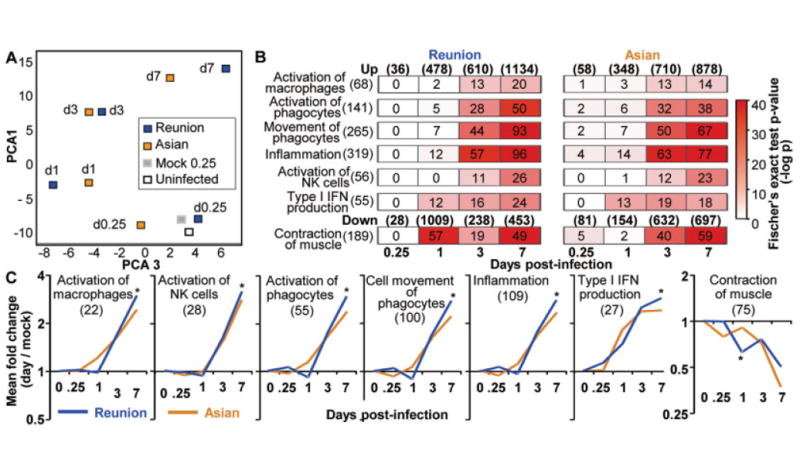Gene profiling of Chikungunya virus arthritis in a mouse model reveals significant overlap with rheumatoid arthritis.
Chikungunya virus (CHIKV) is a mosquito-borne alphavirus that causes a chronic debilitating polyarthralgia/polyarthritis, for which current treatments are often inadequate. To assess whether new drugs being developed for rheumatoid arthritis (RA) might find utility in the treatment of alphaviral arthritides, we sought to determine whether the inflammatory gene expression signature of CHIKV arthritis shows any similarities with RA or collagen-induced arthritis (CIA), a mouse model of RA. Using a recently developed animal model of CHIKV arthritis in adult wild-type mice, we generated a consensus CHIKV arthritis gene expression signature, which was used to interrogate publicly available microarray studies of RA and CIA. Pathway analyses were then performed using the overlapping gene signatures. Gene set enrichment analysis showed that there was a highly significant overlap in the differentially expressed genes in the CHIKV arthritis model and in RA. This concordance also increased with the severity of RA, as measured by the inflammation score. A highly significant overlap was also seen between CHIKV arthritis and CIA. Pathway analysis revealed that the overlap between these arthritides was spread over a range of different inflammatory processes. Involvement of T cells and interferon-γ (IFNγ) in CHIKV arthritis was confirmed in studies of MHCII-deficient mice and IFNγ-deficient mice, respectively. These results suggest that RA, a chronic autoimmune arthritis, and CHIKV disease, usually a self-limiting viral arthropathy, share multiple inflammatory processes. New drugs and biologic therapies being developed for RA may thus find application in the treatment of alphaviral arthritides.
Authors
Helder I Nakaya; Joy Gardner; Yee-Suan Poo; Lee Major; Bali Pulendran; Andreas Suhrbier
External link
Publication Year
Publication Journal
Associeted Project
Systems Immunology of Human Diseases
Lista de serviços
-
Gene regulatory and signaling networks exhibit distinct topological distributions of motifs.Gene regulatory and signaling networks exhibit distinct topological distributions of motifs.
-
Gene signatures of autopsy lungs from obese patients with COVID-19.Gene signatures of autopsy lungs from obese patients with COVID-19.
-
Network Medicine: Methods and ApplicationsNetwork Medicine: Methods and Applications
-
ACE2 Expression Is Increased in the Lungs of Patients With Comorbidities Associated With Severe COVID-19.ACE2 Expression Is Increased in the Lungs of Patients With Comorbidities Associated With Severe COVID-19.
-
Drug repositioning for psychiatric and neurological disorders through a network medicine approach.Drug repositioning for psychiatric and neurological disorders through a network medicine approach.
-
Linking proteomic alterations in schizophrenia hippocampus to NMDAr hypofunction in human neurons and oligodendrocytes.Linking proteomic alterations in schizophrenia hippocampus to NMDAr hypofunction in human neurons and oligodendrocytes.
-
In-depth analysis of laboratory parameters reveals the interplay between sex, age, and systemic inflammation in individuals with COVID-19.In-depth analysis of laboratory parameters reveals the interplay between sex, age, and systemic inflammation in individuals with COVID-19.
-
The evolution of knowledge on genes associated with human diseasesThe evolution of knowledge on genes associated with human diseases
-
Network vaccinology.Network vaccinology.
-
Pyruvate kinase M2 mediates IL-17 signaling in keratinocytes driving psoriatic skin inflammationPyruvate kinase M2 mediates IL-17 signaling in keratinocytes driving psoriatic skin inflammation
-
Transcriptome analysis of six tissues obtained post-mortem from sepsis patientsTranscriptome analysis of six tissues obtained post-mortem from sepsis patients
-
Gene Signatures of Symptomatic and Asymptomatic Clinical-Immunological Profiles of Human Infection by Leishmania (L.) chagasi in Amazonian BrazilGene Signatures of Symptomatic and Asymptomatic Clinical-Immunological Profiles of Human Infection by Leishmania (L.) chagasi in Amazonian Brazil
-
In vitro morphological profiling of T cells predicts clinical response to natalizumab therapy in patients with multiple sclerosis.In vitro morphological profiling of T cells predicts clinical response to natalizumab therapy in patients with multiple sclerosis.
-
Integrative immunology identified interferome signatures in uveitis and systemic disease-associated uveitis.Integrative immunology identified interferome signatures in uveitis and systemic disease-associated uveitis.
-
Gene regulatory networks analysis for the discovery of prognostic genes in gliomas.Gene regulatory networks analysis for the discovery of prognostic genes in gliomas.
-
Revealing shared molecular drivers of brain metastases from distinct primary tumors.Revealing shared molecular drivers of brain metastases from distinct primary tumors.

